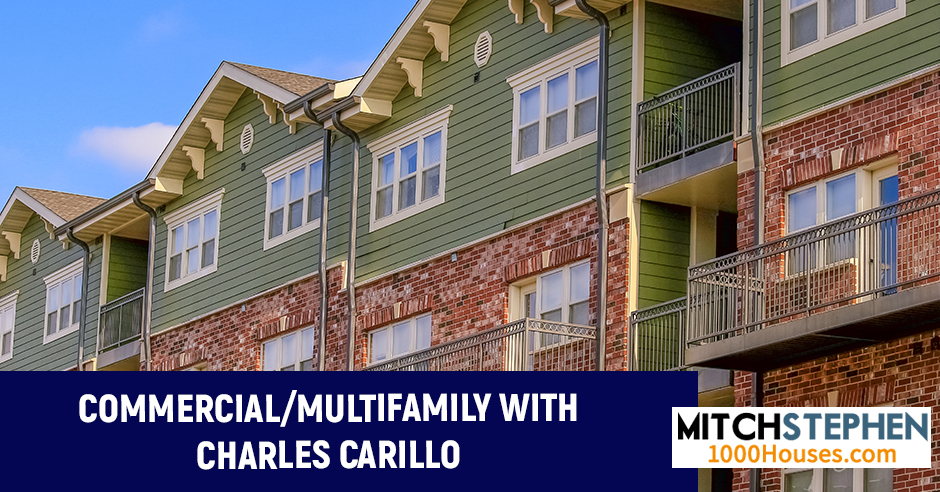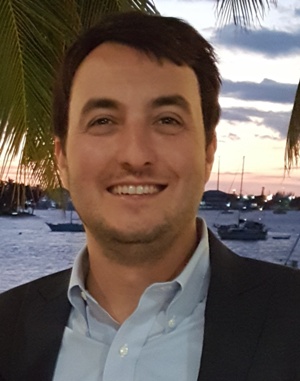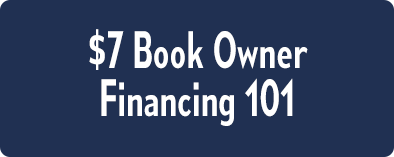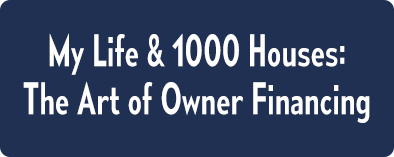PODCAST
Commercial/Multifamily With Charles Carillo
Episode 464: Commercial/Multifamily With Charles Carillo

Charles Carillo was introduced to commercial and multifamily investing by his father, who had been investing and self-managing 100+ units in multifamily and commercial properties since the ’80s. Working alongside his father and eventually investing on his own taught Charles a great deal about how to succeed in this space. In this episode, he joins Mitch Stephen to discuss the importance of getting your numbers right when assessing units for rehabilitation and why it’s vital to raise private money to fund your deals. When it comes to raising private capital, the deal relies heavily on relationships. Why? Charles says that the wealthiest investors he’s ever worked with care most about the operator – you. They invest their money into you because they believe in you. At the end of the day, real estate is all about two things: access to money and building relationships.
—
I’m here with Charles Carillo. He’s out of St. Petersburg, Florida. We’re going to be talking about commercial real estate and multifamily real estate and everything that goes along with it. How are you doing, Charles?
I’m doing great, Mitch. How are you?
I’m doing good. I want to say thank you to TaxFreeFuture.com for sponsoring this episode. It can help you move your retirement funds into a tax deferred or tax-free investment vehicle where you will have checkbook control. The biggest thing about it is the annual fee is a constant $175 per year. A lot of these companies will charge you zero to get in, but they have a big backend and you’ve got to keep paying. The bigger your account gets, the more you pay. The more transactions, it can turn out to be thousands. I had three of them one time and my bill were $9,000 by the time I paid for all three of them. I thought, “I’ve got to find a better way.” I found a place where you could pay $1,500 upfront and then have a flat $175 for the rest of your life per year. I thought that would be better for me. I talked to them, I liked it so much. I made them a sponsor of my show. You have no idea what your financial advisors are not telling you.
We’re going to tell you what they’re not telling you. We’re going to tell you why they’re not telling you. We’re going to tell you what you can do about it, and then you can do about it if you want to or not, but you’re going to be all the wiser for it. Be sure you watch the little 37 video vignettes. They’re free and there are lots and lots of ways to take little bits of money, and without putting any more of your money in, grow it to large amounts. You just need to know the strategies. TaxFreeFuture.com, check it out. Thank you very much. We paid the bills, Charles. You’re in St. Petersburg, Florida. Is that where you do everything or you’re all over the nation? Are you local or what?
I’m originally from Connecticut. I have a small portfolio there. I moved down to Florida in 2012. Where we focus now is mainly in the Southeast. Most of our units are in Florida, but it’s the greater Southeast the Midwest and the Midsouth. We focus on landlord–friendly states first and our team is on the ground there.
The savviest, wealthiest investors care more about the operator. They're investing their money in you. Share on XThat‘s important, landlord–friendly states, especially when you’re dealing more in a residential atmosphere because some of the states, it’s difficult to evict somebody, if not, impossible, if they don’t want to go, if they want a lawyer up. We like to call them sidewalk lawyers. They know more about how not to get evicted than the lawyer does. They’ve been doing it so long. Let’s start out with your beginnings in this business. Tell us how you got started.
I grew up in the business. My dad had been investing in multifamily and commercial properties since the ‘80s. He self-managed all his properties, 100-plus units himself. He had a small team, but he never used a third-party property manager. My education growing up was going to properties and collecting rent and dealing with contractor, listening to him deal with contractors, deal with agents, deal with brokers and everything else that goes on with the fun world of property management and real estate investing. The year I graduated college, I start investing in real estate, multifamily in 2006. I bought a three-unit property. I got a little over my head with it. I figured out what my problems were and bought my next property a couple of years later. I still own them now and spot a commercial property in 2009 at pretty much the bottom of the market, which has fantastic deal. Now what we do is we focus more on syndicating properties. We’re working with passive investors.
You’re dealing off the OPM theory, Other People’s Money, helped you grow a little faster or a lot faster than you could with your own money because we’re all limited in that department for the most part. There’s that 1.00% that don’t need to worry about running out of money, but the rest of us do. Your first deal, you said you got in over your head. Tell me about that.
It was a little three family. It needed a lot more rehab than I was expecting. My dad was helping me along, but he was keeping an arms distance. It was a good learning experience, but when I purchased it, it needed a little bit more work per unit. As you get going, it starts adding up and adding up. It took about two months to get exactly where we want it. Little by little, we finished up a few different things afterwards like a roof here and a couple of things that had to be done. We’ve got it all done. After that, I realized that next time going through it, I would make sure that I had a much more solid plan starting off. My second one I did, it was a little bigger of a property. That’s probably the best property I own 100% still to this day because it’s prince money. I got into that. It was a better property in a better area, even though it was only a few blocks from the other property. That was a big thing too, a better property in better area. It’s amazing how real estate can change a block here and a block there, but it does. That was one thing that was a big difference. The second one was a light rehab, but the first one was a little heavier. If I knew those numbers better going in, it would have been a lot smoother.
I want to throw this in because I interviewed a guy who has a software for rehabs. You can go to 1000Houses.com/TrueEstimate. It’s a pretty phenomenal software because I come to find out that things don’t vary that much from one end of the country to the other. You can usually take the software, go get your contractors to give you a bid and then take that number, put it in the back of your head and then walk through with this software, and then you’ll see they’re amazingly close all the time. I’ve done it twice. I don’t understand how it’s that close, but it has been twice in a row. That’s how it works. There’s always that bumper sticker we make our money when we buy. Yours truly added the little tagline to that bumper sticker. Now the bumper sticker reads, “We make our money when we buy, and we lose it in the rehab.” You’ve got to get good at these estimates or you’ll end up like Charles Carillo and be a little bit upside down when you get done and have to work yourself out of a hole if you don’t get that number right.
The only two numbers you’ve got to get right in this business is what is the property worth after it’s repaired and what does it cost to repair it. It’s do or die, if you don’t get them right, you’re screwed. You get those two numbers wrong and you’re messed up right out of the gate. You’ve got to get those in there. There’s always that dealing with the contractors. That word begins with the word see or and. They were giving you a warning right off the bat. You’ve got to stick with that. What’s your favorite kind of property? You said you were doing multifamily. Was that apartments, duplexes, fiveplexes or what?
It started off with triplexes and then we went into a little bit mixed–use properties, and now we’re into a larger multifamily stuff.
Is there a natural graduation, then to go the hard commercial after that? Is that a natural graduation or is that the way you chose to go?
It’s commercial multifamily, so five-plus units is what our focus is on now. What I like about that is it’s a little bit more scale. It’s much easier for growing into different areas if we were focusing on smaller properties. When I explained the target markets, it would have been a lot narrower because you can’t get any scale buying a five–unit here and a five–unit there, but you’ll get scale when you buy 90 units or 100 units in one area because now you have some leverage there with what your property management company is going to charge you, your onsite manager. That’s what the assets that we’re focusing on now and have been for the last several years.
When you say commercial, you’re not saying strip centers and high-rise buildings or office buildings, you’re talking about bigger apartment complexes.
A bank would consider five-plus units as commercial even if it’s apartments. That’s how I throw it around this commercial multifamily. I do have a couple of properties that are commercial because they’re smaller mixed-use properties, but the majority of what we’re syndicating and everything like that is regular multifamily that’s larger.
Have you ever done any flipping before?
I flipped before, but it’s the contractor. My dad used to do a lot of flipping as well. It was good to keep. The most successful people I saw would have rentals that they rented out right in the town where I started investing in Central Connecticut. They also had flips to keep their people busy between different rehabs and their management. The biggest problem I had when finding flips wasn’t finding the properties or finding the money, it was managing the contractors like how you were explaining it. That was the biggest problem I ever had because something simple doesn’t work like that. It was constant management on people, making sure people are at the property, people are doing things. You have that for a couple months when you’re buying a property to rent out, but afterwards you have to have the relationship if you’re self-managing it with the handyman that’s going to come over and you give them a laundry list, “Here’s five hours’ worth of work. Take care of this. You can get that done.” When you’re flipping a house, time is of the essence where you’re paying so much for money. You’re paying all these different expenses and fees, holding costs and you try to get that thing done within 100 days or so right back on the market sold. That was the biggest problem I have on flipping houses. That’s something that steered away from it myself.
People are always the problem because if it wasn’t for the people, the problems are easier to fix, it’s the people that you’ve hired. The other thing is nothing good happens to a vacant house. I’ve never showed up to one of my vacant houses and someone mowed the lawn and fix the broken glass and painted it. They have painted it before, but it wasn’t like what you would want. Let’s talk about how you’re funding these deals. What’s your average price range of the property and how are you funding them?
I’ll give you an example from our last property in Tampa, we purchased 90 units. It was a 68-unit property, and about a block away from it, it was a 22–unit. We put it into one syndication, into one different investment LLC. We had to get two different loans for it, but we raised $2.3 million. $1.8 million of it came from passive investors, $500,000 of it came from the general partners, the operators, us. What happened was because there were two different loans, we were paying the average of $67,500, something like that, per unit we were buying them for. Rents were averaging when we purchased it somewhere between $715,000 to $825,000 a unit. One of the properties was in a much better shaped. It was well-managed.
The second one, the 22-unit was poorly managed. We got a great deal on that but there was a lot of management that had to be changed over. The guy with the 22-unit, the owner had his ex-son-in-law. He was charging the owner 15% management fee. You can see why it’s his ex. We plugged in $325,000, $350,000 in that area for our property manager. Right off the bat, we were able to minimize our property management fee by almost 80%. We bought it during COVID. We had other assets in the area, so we knew how they performed. We were sure what was going to happen when we bought it. It was one of those things where you don’t know how it’s going to perform when you’re buying in a new area. With COVID, we stayed in areas that we knew when we did this property. Those kinds of things where we’re not raising rent and you’re able to add to the NOI. That’s what happened there.

Commercial And Multifamily Properties: You can’t bring a deal up until you speak to someone.
What was the effect of COVID on your rental income? They put those moratoriums on evictions and foreclosures. What changes did you see during COVID?
We have properties in three different states now. A tenant-friendly state would be Connecticut that I have properties in. I had no problems there. Collections were better during COVID. It’s amazing, less turnover and better collections. There’s a moratorium right there on evictions, but there are ways for people that are abusing it that they can still be evicted. We have one eviction that’s going on there. In our stuff in Florida, that moratorium ended in fall of 2020. With there, we dropped down probably 3% or 4% in collections from a year earlier. A lot of these landlord-friendly states are getting a lot tighter on accepting the CDC letter, which is the Federal Moratorium. You have to prove that you’re hurt for funds. You can’t just say, “I’m hurting for funds. I can’t pay rent.” That’s good, they’re seeing that there’s a lot of abuse in the system and certain states are. If you’re in New York or Los Angeles, they’re not going to be helping you with that, but somebody ruled against it in Texas, a judge in East Texas somewhere. In Florida, they’re cracking down on it. Let’s make it easier, we’re taking back units, retaking possession of units. Our evictions are people who are not paying us, cut in half over the last few months. It’s coming back around where it was before.
I’m going to guess that you’re seeing the value of your properties and the rent is going up pretty good now.
When everything came around in 2020, we were underwriting for this latest purchase. I penciled in there that we weren’t going to be raising rents for eighteen months just to be safe because you have no idea how long COVID was going to happen when you’re buying something in the end of summer of 2020. We start raising rents on our newest acquisition in March 2021, and we start raising on other assets in the same neighborhood in December of 2020. We weren’t planning on raising at all. Not that they’re major raises, but it’s something that when you own rental real estate, you’ve got to have some raise every year because your tenants are anticipating it. You need it because your expenses are going up and sometimes your expenses are going up a lot faster than the rent’s going up. Especially when you’re in a time like this where your insurance is going up, but you might not be able to raise rent. It’s something that you have to raise rents consistently. Not that it has to go up majorly, but it has to fit the market. You don’t want to be having some of that rents for $900 and moving it to $910 where the market’s $1,100. Not that you want to go right to $1,100, but you’ve got to move it along. That adds to the value of the property and helps for you and your investors as well.
Do you have some standard rule of thumb or algorithm like rent increases per year or do you have to go by what the market is telling?
We usually go by what the market is. What we’ve done with COVID, most of the apartments that we have in Tampa, they’re renting somewhere between high $700s to high $900s. We were focusing adding 3% onto it and we weren’t doing anything magnificent for 2020. We just want to get rent increases because we had so much demand, especially for two-bedroom units in Tampa. One–bedrooms are a little harder to rent, I don’t think we have any vacant two bedrooms in Tampa now, which is amazing out of hundreds of units. What we want to do is you want to peg it towards your other competitors, but I’m careful no matter how I said that the CDC, and there’s eviction moratoriums, or attorneys are getting around.
I don’t want to be the guy that’s going to kick someone out or raise rents too high and a good tenant leaves because every time you’re rolling the dice with a new tenant, you have no idea. They can look perfect on paper, you put them in the house, and they can be terrible. It’s difficult. People are like, “We’re still going to be renovating apartments.” We’re going to be painting and cleaning them until all the moratoriums are over and we can restart our value add when we’re renovating the properties and upgrading them. We have good tenants in there, we’re going to keep them. That’s going to be safer for our investors and it’s the right thing to do at this point. A 2% or 3% rent increase is normal. It holds up with inflation.
Let’s talk to the audience that might want to consider investing passively or otherwise in maybe your next project. What does that process look like?
If someone’s interested in investing, they can set up a call with me. Once we do a call together or someone on my team, we’ll add you on to our deal list. When we have a deal that’s under contract, we send out an email to our deal lists. If something interests you, you can set up a call with one of us. You can also do soft commitment, which is a short form you’d put through that’s non-legally binding that says, “On a scale of 1 to 10, where do you find yourself interested in investing in this?” They’re asking questions. Some people are like, “I’m 100% in.” That gauges us when we’re talking to people how much is left of this fund or to raise, then we can figure out exactly how much more we need to accept from investors and when we should tell investors that we’re getting close to fully subscribed.
Are you trying to raise some money for a project now?
We don’t have anything under contract now. With the SEC rules, we need to have that call first before I start talking about deal if I had one. It’s difficult. It’s even more difficult than 2020. It’s amazing. Every year it’s getting more and more difficult finding deals that penciled. We were out bid on a 100–unit property in Kansas City. It’s amazing what people are paying and when you see them closing out. We’ll see what the next couple of years hold for commercial multifamily.
Your investors need to be accredited. Let’s explain that to the readers.
We do accredited and non-accredited. Accredited investor is someone that makes $200,000 a year as a single person or $300,000 as a couple, or they have $1 million in assets not counting their primary residence. How we do these is we do it with a pre–existing relationship. That’s why I can’t bring a deal up until I speak to someone. We accept unaccredited investors as well, we call them sophisticated investors, for the deals. That’s someone that understands real estate. You’ve gone to a conference. You’ve read some books. You listen to Mitch’s show and you understand what’s going on with it, but you’re not at those numbers that I mentioned. We open up to that as well.
For you, investors, out there that are doing things on your own and you’re your own entrepreneur, it’s another testament that private money or learning how to raise private capital or find people to fund your deals is critical. If that’s all you learn in 2021 is how to raise private money, then that is a super good place to focus. I functioned off $26 million of private money. I’ve been buying a house for every 4 to 5 days in San Antonio, Texas or surrounding area for decades. That’s not possible on almost anybody’s checking account. You have to have other people’s money and you have to find a way to offer the people enough return, but keep it low enough that you can still leave yourself some room, so it has to be a win-win. You have to show a certain amount of security or explain to them why you know what you’re doing or how you know what you’re doing and these deals are decent and good deals. That’s what your credibility package too. I’m going to guess you have a long string of references by now. You’ve been doing this for a long time.
In real estate, no matter where you are, there are two things that give you a competitive advantage: relationships and access to money. Share on XI have a credibility book that we send out and some other information on different projects that we’ve done. We send out a sample deal to people when we talked to them of what we’ve done previously, but the other thing too is about raising private money, is that the savviest, wealthiest investors that I work with, they care about the deal, don’t get me wrong, but they care more about the operator. That’s what they’re investing their money into. They’re investing their money into you. If the deal goes bad, they’re the ones that are going to invest with you again because they believe in you and hopefully, the second one doesn’t go bad. The thing though is that the deal’s important, but the wealthiest people I’ve ever dealt with, they want the sponsor to go through their phase of literal application process. They want to check you out and make sure that your mindset is right for you to finish the deal. Keep that in mind.
It is a tough market out here to find places now. You see many people putting these apartment complexes up for 4%, 5% and 6% cap rates. It’s crazy. A certain amount of them is selling and it’s always eye opening. How are you able to find good deals on these places during this economic time where these places are booming?
In real estate, no matter where you are, there are two things that will give you the competitive advantage over your other people that are buying. It’s going to be your relationships and your access to money. We have a couple of different strategic partners that we buy properties with in the United States. One of them has brought on a commercial broker onto their team. They’re having this person sort out deals. They’re giving them a higher percentage, not trying to get the best deal per se. We’re trying to get deals where we don’t have to be closing in 30 days or something crazy where we have money going hard on the first day. A lot of these groups are doing that, which means that what’s going hard, you’re not getting it back if something happens, and it’s risky.
Other groups have their own way of doing it if they have brokers they’re working with. You have decades and decades of experience so you have relationships that others don’t. That’s how your competitive advantage is, where you’re able to find deals that others might not have access to. They’ll call you first. You know they can close. That doesn’t matter if you’re in single–family or multifamily or any other asset class within real estate. It’s building out those relationships. That’s how important it is just like your investors are. Every portion of it, the money, your lenders, your debt people, your equity people, if you’re accepting money from passive investors and also where you’re getting deals, your brokers. These are all important pieces. You have to keep on nurturing these relationships to get ahead of other people in the industry.
In your world, what’s the difference between the passive investor you talked about and what’s the other word?
An active investor. When we’re in a deal, usually when we’re having these syndications, there’s going to be two different parties. There’s going to be the limited partners or passive investors and general partners, which are also called operators, sponsors or whatever it might be. That’s where we fit in. When we’re finding a deal and going through the process, we’ll put money where our general partners put $500,000 in and then we raised over 40 different investors to $1.8 million to finish it out. That $500,000 when we invest it, that goes in on the passive side of it because that’s our investment. We were getting paid on both sides. We’re going to get paid on the operating side, which is usually about 30% of the deal, and then on the passive side, they’re usually keeping 70%.
You have that alignment of interest with your investors because in most cases, you’re investing more money than your investors individually. If you put in $100,000 and your investors are all investing at $50,000 or $25,000, you have more at risk than they do, plus you’re managing the deal. It’s that fine line between getting a return, but also making it worth your while. Another thing with dealing with sophisticated investors is that less sophisticated one are looking to try to get every point out of the sponsor, out of the general partners. The more sophisticated investors want to make sure there’s enough upside for the operators of the deal so that they will finish the business plan. They’ll do the renovation, renovate the units, raise the rents, manage it correctly, everything that goes along with a successful apartment complex. It’s a fine line. You can’t go off of other people. It’s also what your investors will accept. You’ll have some investors that might be comfortable with you that will accept the lower return for working with you.
When you’re talking about the active investors, they need to have a decent upside because they’re doing all the work and all the heavy lifting. You don’t want them to run out or give up or get disenchanted because all the passive investors are not in the game, they’re just watching from the stands. What’s an acceptable return on average for people? Are they super ecstatic when they make 7% on their money or is that an average number? What’s the range that your passive investors seem to be satisfied with in rate of return?
Typical in the industry it’s a 7% to 9% cash-on-cash return. For instance, if someone’s putting in $50,000 into an investment and they’re getting an 8% cash-on-cash, that’s going to be about $1,000 every quarter, about $4,000 a year. That’s just the cash-on-cash portion of it. You have all these other portions that you’re getting paid on, but not in cash quarterly as a quarterly distribution. You’re paying principal on your mortgage. You have the appreciation on your property. Everything, all the management efficiencies, you’re probably not getting that paid out to you. That’s staying on the equity that you’re building up one way or another. When the total property is sold, that’s when you’re focusing on an average annual return after everything of about 15%.
That’s what you would expect. Some people will go higher than that. It depends on the deal they have. I invest passively and mainly active. When I’m investing passively, it’s the cleanest way of investing because if you can make 7% or 8% cash-on-cash plus add some 5, 7, 10 years down the road, I’m going to possibly get that to over 12% or 15% when it’s sold or when it’s refinanced or both. We refinance it first and then we sell it a few years later to get money back out to the investors and ourselves. The only way I know of it other than probably investing in REITs is to passively invest. Mostly people say, “I’ll buy real estate.” It’s like buying a business because if you’re buying apartment complex, even if you’re just doing the asset management and you have a full-time property manager, it’s a semi-passive thing, but you still have to keep an eye on them.
That’s the biggest snake oil potion they’ve been selling for the longest time that rent houses are passive income. That’s complete bullshit. I never seen a passive rent house in my life. There was this definition of financial freedom that said, “Financial freedom happens when your wants and your needs are exceeded by your passive income.” I struck the word passive and I said, “When your wants and your needs are exceeded by your cashflow.” I don’t even believe anything is passive. Sleep’s not even passive because you’ve got to get up and go eat at some point or else, you’ll die. I don’t like the word passive anymore. It’s overused. People are putting it in places that has no business being put in. I want everyone to go to 1000Houses.com/Carillo and get a free consult, get on board, they’re always looking for deals like every good investor. There’s another deal tomorrow and we’re always looking for it.

Commercial And Multifamily Properties: You have to keep on nurturing relationships to get ahead of other people in the industry.
If you don’t have a deal now, that doesn’t mean that you wait because it can even be too late by then. Let’s get onboard, find out what’s going on, give yourself time to do your due diligence on Charles and his company and get acclimated to what’s going on, and also be able to express to him your interest level. It’s a lot easier to go out and buy something when you know you got people behind you. Anything else you want to address before we wrap it up? There’s a lot of probably newbies on this channel. There’s probably a lot of retired people wondering what to do with their funds. Some people think they want to be you or me, but it’s a lot of work and they decide that they don’t want to. They end up investing with us instead passively so that you’re not out there doing the heavy lifting. How should someone expect that consult to go and how long does it take?
We’ll do about 30 minutes. What we are is we’re getting to know each other. I’ll send you all the information on our company, we’ll talk, and this is what has to happen. It’s where we start in the eyes of the Securities and Exchange Commission. It’s where we start a relationship. After that, I can add you to our deal list and we can keep in contact. When you’re on the deal list with us, if you don’t like it, you delete the email. If you like it, then we can talk about it. Nothing’s legally binding. Everybody has different questions. Everybody has different return requirements and different risks that they’re willing to accept. We’ll see how every deal goes.
Charles, I appreciate you taking the time to be on. Did we cover what we needed to cover?
Yes, definitely. Thanks, Mitch.
I appreciate you being on. Remember, you can probably use your retirement funds to do this. I’m not exactly sure, but I’m pretty sure you can invest your retirement funds. It would help if you had a self-directed retirement fund with checkbook control. That’s what Tax-Free Future does. They offer retirement vehicles, the tax deferred, tax free. You can also borrow money out of these accounts sometimes. All of this stuff you can learn in about 37 little video vignettes talking about some interesting things that you can do with your retirement funds to take control of your financial future and accelerate the growth of your retirement funds. Check it out, TaxFreeFuture.com. I’d like to thank everybody out there for stopping by to get you some Charles Carillo. We’re out of here. Thanks a lot, Charles.
Thank you.
Important Links
- 1000Houses.com/Carillo
- 1000Houses.com/TFF
- 1000Houses.com/Livecomm
- 1000Houses.com/100
- 1000Houses.com/101
About Charles Carillo
 Charles Carillo is managing partner of Harborside Partners; a real estate syndication firm and has been actively investing in multifamily real estate since 2006.
Charles Carillo is managing partner of Harborside Partners; a real estate syndication firm and has been actively investing in multifamily real estate since 2006.
Charles also hosts the Global Investors Podcast where he interviews professionals about investing in US real estate.











